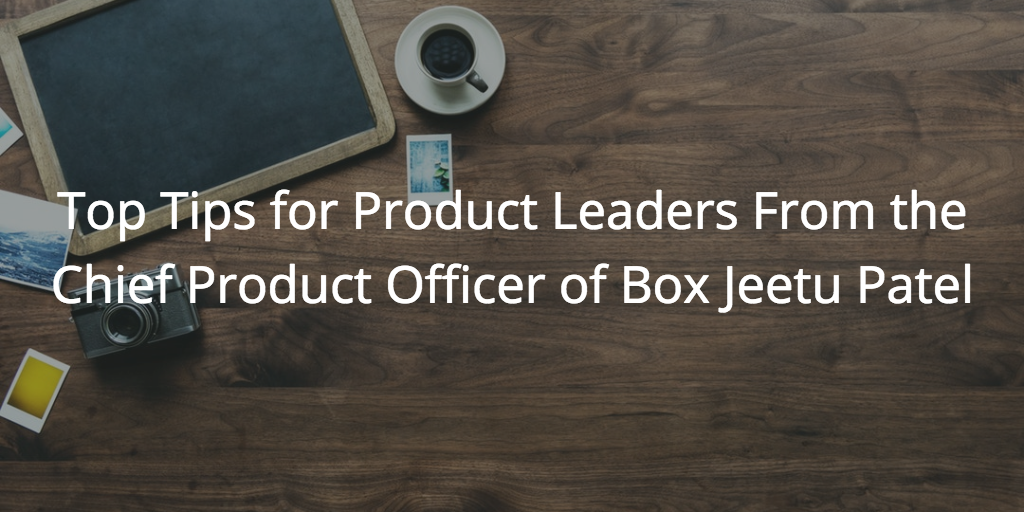During Aptrinsic’s Mastering Product Adoption and Growth event, industry-renowned product leaders shared their insights into driving product growth.
Aptrinsic is now Gainsight PX! Gainsight PX helps your team deliver superior product experiences while Gainsight’s customer success platform helps to ensure customers are receiving business value from the product.
Here is a summary of the tips shared by Jeetu Patel — Chief Product Officer for Box — on how to run an effective product organization. Since its founding in 2005, Box has made it easier for people to securely share ideas, collaborate and get work done faster. Today, about 76,000 businesses and more than 56 millions users trust Box to manage content in the cloud.
According to Jeetu, one mistake on the product management side has ripple effects for years to come. Teams of engineers get misdirected, product marketing goes out with the wrong message, sales sells the wrong thing and customer success faces escalation issues. Because it’s such an important job with lots of responsibility, product managers can’t afford to mess up. Jeetu advises that product managers embrace the following 10 lessons as a rubric for leading their companies to success.
#1. Pick the right problem to solve.
As Jeetu says, this is the most important thing a product manager can do. The quality of the problem you pick is directly proportionate to the caliber of people you’ll attract to solve the problem. It’s counterintuitive but if you pick an easy problem, your likelihood of success is no greater than if you pick a hard problem. That’s because mediocre people show up to solve easy problems. As a result, you won’t get the desired outcome. If you pick a really hard problem, you’ll attract top talent and achieve a good outcome
Deeply consider the problem you want to solve as you think about building a product — Is it actually a problem? Is it a problem people are going to be willing to pay money to solve? Work backwards from the problem rather than try to force a feature to fit a problem.

#2. Think 10x.
If your product improves a current process by 20%, it’s not enough to motivate people to give up the status quo. Unless you’re 10 times — or orders of magnitude — better than the current state, chances are people will not move to the new way of doing things with you. The inertia and the amount of work it takes to move is far greater than the value they’ll realize.
You have to think 10x in the core, initial value thesis — the value proposition — you are going to deliver to the market or you’ll find abysmal adoption. Until you identify that value proposition, nothing else matters because adoption and growth only happen for solutions to meaningful problems with a 10x value.

#3. Build experiences people love and can’t live without.
Jeetu says at Box, they ask, “Are we going to be a vitamin or are we going to be a painkiller?” It’s much better to be in the painkiller business. Vitamins are nice to have. That said, it’s hard to disprove the value of a vitamin in user feedback sessions because people generally want to be considerate, so they’ll say, “Yes, that’s helpful.” However, when it comes to putting hard cash on the table for your product, people won’t feel a sense of urgency to make the purchase unless you’re a painkiller. When building a product, build it more on the painkiller side than on the vitamin side. And build immersive experiences that people fundamentally love.

#4. Obsess about product/market fit.
Generally, companies find themselves in one of two stages: before product/market fit and after product/market fit. When you’re before product/market fit, nothing else matters but getting to product/market fit.
Box discovered that in the phase of getting to product/market fit, having abundant resources is actually your enemy. Scarcity brings about creative thinking, so Jeetu advises keeping teams extremely small in this phase.
Once you get to product/market, typically the second phase in the enterprise space is to identify a repeatable selling motion. You don’t want to sell snowflakes. You want to sell the same thing over and over. You need to identify the use cases that are going to be continually consumed. Once you’ve picked out a repeatable selling motion, and then think about scaling. If you start scaling before you get to product/market fit, it’s a complete waste of effort.
Product/market fit is when you have retention. Product retention means someone used your product, found it valuable, came back again to use it, found it valuable again, and came back again. In other words, they find so much value in your product that using it becomes a habit. When people keep coming back to your product, you’ve got product/market fit.
Remember: Getting to product/market fit doesn’t mean you have it forever. You lose it pretty quickly so you must constantly ask yourself, “Are we at product/market fit? Have we lost it? How do we resurrect it?”

#5. Retention drives growth.
If your users aren’t staying with you, don’t focus on the top of the funnel because it just becomes a leaky bucket. If your retention curve asymptotes to zero really quickly in the early weeks, you’ve got a problem you must fix above all else. In other words, if you see 90% attrition after the first login, there’s no point investing in the top of the funnel. You need to first fix the product problem.

#6. Don’t ignore the marginal user.
The product management community has a huge blind spot because we think about users as power users. Most of your challenges aren’t with power users — they’re with the occasional user, what Alex Schultz at Facebook calls the “marginal” user. When you build capabilities for the power user, the people who are already using your product will keep using it more and more. To drive growth, focus on the marginal user.
It’s helpful to think of this in terms of how it aligns with your product maturity. When you are getting to product/market fit, all you need to focus on is making sure power users see the value and you retain them. Once you get past product/market fit and you’re trying to scale, focus on marginal users, even though they’re the easiest ones to ignore. Instead of coming up with 15 more things existing users could do with your product, focus on what marginal users are doing most of the time with your product and build features that drive them back to your product.

#7. Define organizational unit (PEAPOD).
Very large teams tend to lead to administrative nightmares when it comes to keeping everyone up to date. The key to having a high-velocity, innovative culture is keeping teams small. Amazon approaches this by saying, “We should be able to feed every team with two pizzas.” While you sometimes need bigger teams, this is a good general rule.
You need a certain set of roles on these teams or pods. PEAPOD is an acronym for the composition of teams at Box.
P = Product Management
E = Engineering
A = Architect
P = Program Management*
O = Online Growth
D = Design
Two notes:
- Program Management should be different from Product Management because it takes different skills to run the trains on time than to come up with the next big product idea.
- You won’t necessarily have just one person for each of these roles but these are the key roles in a pod.
It’s completely okay to be pursuing many goals in a company, but it’s not okay for one team to be working on more than one or two goals. That results in dissipation of energy. At Box, every team is measured on one or two major metrics.

#8. Hunger and curiosity trump all else.
When hiring, Jeetu looks for those with hunger and curiosity. Without enough of those characteristics, even the smartest or most technical person on the planet won’t do things the way they need to be done.

#9. Half-life reduces dramatically in the digital age.
The half-life of a company and the business model today is shrinking dramatically. In the past, companies’ half-lives were 25–30 years. Now it’s 5-to-7 years and the core product lifecycle tends to be about 36 months. That means somewhere between 5 and 7 years, the company’s business model completely changes. So, if you take two years to build a product, chances are by the time you release it, you’ll be too late to the market.

#10. Purpose matters.
You’re going to experience hard times in a company. It’s easy to keep people around during the good times. If you have the right level of mission and purpose in teams and in the company overall, you’ll keep people around during the bad times too.

#11. In order to hyperscale, don’t think about hyperscaling.
First do things that don’t scale so that you can sustainably scale. If you’re launching a product that’s breakthrough, it’s natural to think about how to scale to millions of users. Box uses an F10 program — standing for — Flagship 10 customers — internally. Whenever Box launches a product, the product team has to acquire the first 10 extremely happy customers in a completely non-scalable way. If they need to fly out an engineer or product manager to get the product up and running, they would so in this phase. Box does this at the early stage because if you can’t make customers happy with that amount of white-glove treatment, you won’t be able to do make them happy at scale.

Watch full presentation
Top Tips For Product Leaders by Jeetu Patel
Read the full “Mastering Product Experience: How to Deliver Personalized Product Experiences with Product-led Go-to-Market Strategy” book written by the Aptrinsic team: Nick Bonfiglio, Mickey Alon, and Myk Pono.
In this book, we share what we have learned about what it takes to succeed with a Software-as-a-Service (SaaS) company. We explain how to deliver a winning customer-centric experience strategy to your customers throughout the customer lifecycle, from acquisition to up-sell/X-sell. We show how to implement a faster and more effective product-led go-to-market strategy to meet changing customer expectations. And we share how to optimize Customer Acquisition Cost (CAC) and increase Customer Lifetime Value (CLV) by building better contextual relationships through personalized product-driven engagement.

